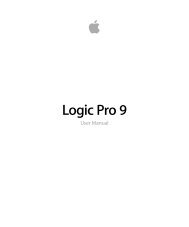Soundtrack Pro 3 Effects Reference (en).pdf - Help Library - Apple
Soundtrack Pro 3 Effects Reference (en).pdf - Help Library - Apple
Soundtrack Pro 3 Effects Reference (en).pdf - Help Library - Apple
You also want an ePaper? Increase the reach of your titles
YUMPU automatically turns print PDFs into web optimized ePapers that Google loves.
Space Designer Surround Output Configuration Parameters<br />
• C(<strong>en</strong>ter) slider: Adjusts the output level of the c<strong>en</strong>ter channel indep<strong>en</strong>d<strong>en</strong>tly of other<br />
surround channels.<br />
• Bal(ance) slider: Sets the level balance betwe<strong>en</strong> the front (L-C-R) and rear (Ls-Rs) channels.<br />
• In 7.1 ITU surround, the balance pivots around the Lm-Rm speakers, taking the<br />
surround angles into account.<br />
• With 7.1 SDDS surround, the Lc-Rc speakers are considered front speakers.<br />
• Rev(erb) slider: Adjusts the output level of the effect (wet) signal for all channels.<br />
• Dry slider: Sets the overall level of the non-effect signal for all channels. Set this to a<br />
value of 0 (mute) wh<strong>en</strong> using Space Designer as a bus effect in an aux channel strip.<br />
Use the S<strong>en</strong>d knob of each bussed channel strip to control the wet/dry balance.<br />
Working with Pre-Dly (Predelay) in Space Designer<br />
Predelay is the amount of time that elapses betwe<strong>en</strong> the original signal and the initial<br />
early reflections of the reverberation.<br />
For a room of any giv<strong>en</strong> size and shape, predelay determines the distance betwe<strong>en</strong> the<br />
list<strong>en</strong>er and the walls, ceiling, and floor. Space Designer allows you to adjust this parameter<br />
separately from predelay, and over a greater range than what would be considered natural<br />
for predelay.<br />
In practice, an extremely short predelay t<strong>en</strong>ds to make it difficult to pinpoint the position<br />
of the signal source. It can also color the sound of the original signal. On the other hand,<br />
an excessively long predelay can be perceived as an unnatural echo. It can also divorce<br />
the original signal from its early reflections, leaving an audible gap betwe<strong>en</strong> the original<br />
and reverb signals.<br />
The ideal predelay setting for differ<strong>en</strong>t sounds dep<strong>en</strong>ds on the properties of—or more<br />
accurately, the <strong>en</strong>velope of—the original signal. Percussive signals g<strong>en</strong>erally require<br />
shorter predelays than signals where the attack fades in gradually, such as strings. A good<br />
rule of thumb is to use the longest predelay possible before undesirable side effects, such<br />
as an audible echo, begin materializing.<br />
Obviously, these guidelines are int<strong>en</strong>ded to help you design realistic-sounding spaces<br />
that are suitable for differ<strong>en</strong>t signals. If you want to create unnatural sound stages or<br />
otherworldly reverbs and echoes, feel free to experim<strong>en</strong>t with the Pre-Dly parameter.<br />
Using Space Designer’s IR Start Parameter<br />
The IR Start parameter <strong>en</strong>ables you to shift the playback start point of the impulse<br />
response, which will effectively cut off the beginning of the impulse response.<br />
150 Chapter 11 Space Designer Convolution Reverb
















